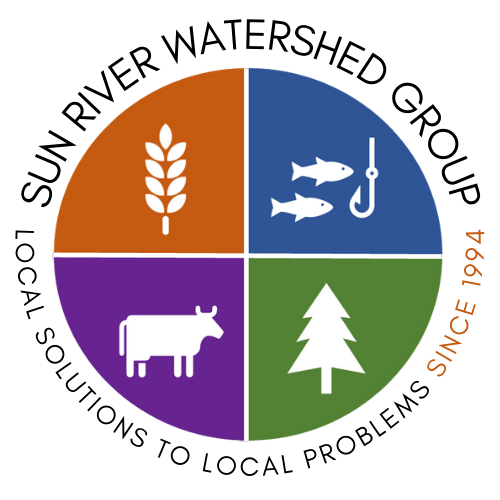SRWG Water Quality Montioring Pros + Cons
By Madison Colyer, SRWG Watershed + Outreach Program Coordinator
If you haven’t heard of water quality monitoring, sometimes also called water quality sampling, don’t fret!
As the Watershed and Outreach Program Coordinator, I am here to help and fill in some gaps. Don’t worry, this will not be a blog filled with weird scientific jargon that only 4 people really understand. Mostly, I want to list some pros and cons to volunteering for water quality sampling. And why you (yes, you there, reading this) should consider contacting me to volunteer for one of our sampling days this season.
Let’s start with a map because who doesn’t like a good map…
This is a map of the Sun River Watershed area (outlined in orange) in reference to the City of Great Falls (far right, green pin). The Sun River Watershed intersects three counties and encompasses multiple towns in its approximately 2,200 square miles of drainage area.
The Sun River Watershed Group (SRWG) aims to monitor the water quality over this entire area. Our sampling efforts began in response to the Watershed Restoration Plan and Total Maximum Daily Loads report created by the Department of Environmental Quality (DEQ) in 2004. A link to the entire 2004 report can be found on our Resources webpage under the Reports section. This report identified potential waters within the Sun River Watershed that were considered impaired by pollutants. Our present-day water quality monitoring sites and sampling locations are based off the listed impaired waters within the 2004 report. The SRWG has been using these impairment listings to help target our projects, plans, and events addressing the water quality issues listed. We have been monitoring these sites, collecting data, and completing restorative projects along the Sun River and its waters in an effort to address and lower the impairments listed over 20 years ago by DEQ.
To complete data collection, we physically go to different locations along the Sun River itself, as well as tributaries – streams that flow into the Sun River – and fill sample bottles with water from those locations (see the purple circular markers). The sample bottles we collect are then shipped to an analytical lab in Helena where they run tests to determine levels of parameters such as nutrients like Nitrogen and Phosphorus, and physical properties, like Total Suspended Solids. The returned lab reports we receive help us analyze trends within the watershed over time. Visit our Water Quality webpage to see the Data Hub where our collected data is uploaded every year.
You may be asking, “Madison. Is the Sun River getting closer to achieving goals of lowering impairments stated in the 2004 report?” And my short answer to your question would be “Yes, we have seen decreases in concentrations of nutrient trends at a few sites; however, not every site has had a decrease and seasonal stream flows have a big impact on levels of concentrations.” That is a very condensed answer for you. So, I encourage you to check out our Water Quality StoryMap found on our Resources webpage for more information regarding our water quality trend analyses.
Now that you have an idea of where we sample, why we began sampling over 20 years ago, and what happens with those physical samples, let me tell you some simple pros and cons to why you should volunteer with me to do the sampling and help us protect our local resources here in the Sun River Watershed.



